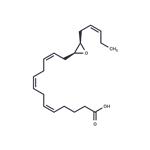EDHF (endothelium-
derived hyperpolarizing factor) is an unidentified mediator released from vascular endothelial cells in response to acetylcholine and bradykinin which is distinct from the NOS-
(nitric oxide) and COX-
derived (prostacyclin) vasodilators.
1,2 Cytochrome P450 (CYP450) metabolism of polyunsaturated fatty acids, produces epoxides such as (±)14(15)-EpETrE which are prime candidates for the actual active mediator.
3 However, the CYP450 metabolites of eicosapentaenoic acid (EPA; ) and docosahexaenoic acid (DHA; ) have been little studied relative to arachidonate epoxygenase metabolites. (±)14(15)-EpETE is the ω-
3 homolog of 14(15)-
EpETrE, derived
via epoxidation of the 14,15-double bond of EPA. The EDHF activity of (±)14(15)-EpETE has not yet been determined.
1. Chataigneau, T., Félétou, M., Duhault, J., et al. Epoxyeicosatrienoic acids, potassium channel blockers, and endothelium-dependent hyperpolarization in the guinea-pig carotid artery Br. J. Pharmacol. 123(3),574-580(1998).
2. Fisslthaler, B., Popp, R., Kiss, L., et al. Cytochrome P450 2C is an EDHF synthase in coronary arteries Nature 401(6752),493-497(1999).
3. Baron, A., Frieden, M., and Bény, J.L. Epoxyeicosatrienoic acids activate a high-conductance, Ca2+-dependent K+ channel on pig coronary artery endothelial cells J. Physiol. 504(Pt 3),537-543(1997).

